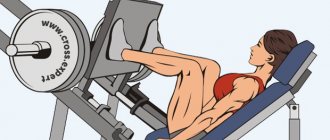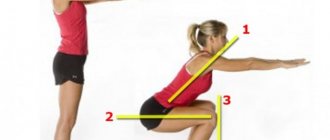© liderina — stock.adobe.com
Share:
Squats are one of the most effective exercises that tone different muscle groups, help you lose extra pounds and build muscle mass. Therefore, both beginners and sports pros include it in their training program.
Proper breathing during squats plays a huge role in the benefits and effectiveness of the element. The body spends a lot of energy to perform even one squat, so it needs a sufficient amount of oxygen. It is ensured by proper breathing.
Benefits of proper breathing
Proper breathing during squats is essential to achieve maximum effect. All aerobic and strength exercises must be accompanied by proper technique and breathing. This is the only way to improve performance and achieve health safety. Breathing technique needs to be taken more seriously when increasing the weights on squats. Inhalations and exhalations made at the right moment will help overcome the most difficult moments of the movement. As a result, you will be able to do more repetitions to optimally work the muscles.
The main thing with any training is to replenish the body with oxygen, which it spends in large quantities. Therefore, it is important not only to take deep breaths and exhales, but also to take them at the right moment. For example, exhalation should occur with maximum effort. In this case, a uniform distribution of the necessary substances into the internal organs and muscle tissue is ensured. When the lungs suddenly fill with air or are emptied in jerks, the load on the heart increases. An athlete can be overtaken by hypoxia, accompanied by loss of consciousness right during training.
Why you shouldn't hold your breath
Breathing during push-ups, aerobics, weight lifting, flexibility exercises and other types of training is necessary to ensure sufficient oxygen supply to the body. Its lack interferes with the normal functioning of cells. This leads to anaerobic glycosis, characterized by a decrease in the ability of the muscles to withstand the load during exercise. Holding your breath causes a lack of oxygen, which is also necessary for the breakdown of fat and natural energy expenditure. Stopping breathing during exercise increases blood pressure and pulse.
This, combined with strength training, can cause serious harm to the health of those suffering from hypertension or hypertension. In addition, holding your breath leads to hypoxia of the brain, which can cause micro-tears to appear in its capillaries. It will take at least a few minutes to restore the heart rate that increased during training with breathing stopped. In addition to the negative impact of a lack of oxygen on the cellular processes of the body, the intensity of the exercises performed will decrease, which will delay the desired result and reduce the benefits of the exercises.
Errors in technology
The main mistake of beginners and amateurs is neglecting breathing techniques or finding their own rhythm during power loads.
Also common mistakes are:
- Excessive concentration on breathing, which reduces the quality of the exercise performed.
- Perform deep breathing cycles before each strength exercise to create a “reserve” of air. A good warm-up with proper breathing technique, performed before the entire workout, will be more effective.
- Holding your breath at maximum load.
- Start the exercise by exhaling after shallow breathing. Before physical activity, it is still recommended to take 1 sufficient breath.
- Inhale during movements that compress the chest, and exhale during movements that expand it.
You need to breathe properly when performing any physical exercise. Breathing is equally important for dips and dips, yoga practices and water sports. An incorrect rhythm of inhalation and exhalation or its absence can not only reduce the effectiveness of exercises, but also cause damage to the health of the trainee. Many of the exercises have their own breathing characteristics, which it is recommended to familiarize yourself with in advance.
Synchronizing your breathing with exercise will speed up results, reduce fatigue, allowing you to complete more repetitions, and ensure good health after training.
Article author: Cash Diver (antihelper)
Varieties of breathing
From a physiological point of view, breathing is divided into two types:
- Chest breathing. It is common to almost all people in everyday life in a calm state without physical activity. With this breathing, the chest expands and the ribs rise.
- Abdominal breathing. Involves the participation of the diaphragm in the breathing process. It changes the volume of the chest, rising and becoming denser. This type of breathing is developed only under conditions of training and effort. It's deeper and more complete.
When doing squats, preference should be given to abdominal breathing. When a person is in a calm state, the portion of air that is obtained during chest breathing is enough for normal functioning. When squats, the diaphragm begins to work along with the lungs. It fills with air, pressing from the inside on the chest, expanding it and increasing the volume of oxygen.
If we don’t think about chest breathing, inhaling and exhaling on a subconscious level, then we should learn abdominal breathing. The technique for doing it is as follows:
- We take in air through the nose and try to direct it to the lungs and stomach area.
- We protrude the stomach slightly forward, expanding it to its maximum size.
- Slowly push carbon dioxide out through the nose or mouth, while simultaneously drawing in the abdominal muscles and tensing the abs.
When squats, exhalation and, accordingly, retraction of the abdomen should occur at the moment of lifting.
Breathing while resting between squats
When a person trains, special attention should be paid to breathing during rest.
Otherwise, the trainee:
- will not be able to fully recover between sets of squats;
- his heart rate will not have time to normalize;
- there will be additional stress on the lungs and vascular system;
- gets tired quickly;
- may lose consciousness during the next series of squats.
To prevent all negative consequences during rest, it is recommended:
- Inhale and exit exclusively through your nose.
- When inhaling, try to get as much oxygen as possible into the lungs.
- Exit should be done smoothly and until the chest is cleared of oxygen.
Breathing during classic squats
It is recommended to begin mastering the technique of squats and proper breathing when performing them with your own weight, that is, without a barbell or dumbbells.
The training will look like this:
- We take the starting position and free the lungs from carbon dioxide (exhale).
- We smoothly lower ourselves down, clench our lips tightly, and slowly inhale air through our nose. There is no place for haste: you still won’t be able to capture more oxygen than your lungs can accommodate.
- Inhalation must be stopped at the moment when the thighs are parallel to the floor - the time for exhalation begins. As we rise, we push carbon dioxide out of the lungs, and we can only finish exhaling at the moment of raising the body halfway, that is, we do it more intensely than when inhaling. You can exhale through your mouth.
Important point! When performing the element, the arms should not hang along the body - this prevents the chest from expanding. It is better to stretch them out in front of you or fold them in front of your chest.
It is recommended to do squats in several approaches of 10-15 times. Between approaches, a short rest is required in the form of at least five full inhalations and exhalations. You should fully restore your breathing during this rest.
Squat technique, how to squat correctly
Squats are an excellent exercise for strengthening the muscles of the lower body, since they work several muscles at once (glutes, hamstrings, quadriceps, core stabilizer muscles). For the same reason, squats are considered one of the basic exercises. Squats also perfectly strengthen the knee, ankle and hip joints.
As a rule, if you feel how the muscles that this or that exercise is designed for work, this already indicates that the exercise is being performed correctly. If you squat incorrectly, your muscles will not only not receive the necessary load, but there is also a high chance of injury. If you feel the load on your legs, but there is no feeling that your buttocks are working, most likely, the exercise is simply not suitable for you.
So, in order to master the classic squat technique you need:
- Place your feet shoulder-width apart (let your knees point slightly to the sides).
- Place your hands along your body, hold them in front of you in a lock, or put them behind your head - you need to independently find a comfortable and safe position for your hands when performing the exercise.
- We look straight, don’t lower our heads.
Video: Squat technique
As for the number of repetitions and recommended approaches, for beginners it is necessary to do at least 15 repetitions, then the number of repetitions can be gradually increased to 30. The main thing to remember is that it is not the number of repetitions that is more important, but the technically high-quality execution of the exercise.
- It is very important to correctly distribute the weight between the legs - when we go down, the center of gravity should be somewhere between the heels and toes.
- Under no circumstances should you slouch or round your spine while performing a squat - this can lead to injury.
- The position of the hands when performing the exercise should help maintain body balance. They should not dangle or hang.
- The squat should be deep enough (the angle at the knees is no more than 90 degrees). If the squat is not deep enough, the muscles will not receive the necessary load, and the entire approach will be done in vain.
Breathing while squatting with a barbell
Loaded squats allow you to pump up your hips and buttocks, as well as develop your abs and lumbar region. Therefore, after mastering regular squats, you can move on to the option with weights, for example, with a barbell or dumbbells.
© Vitaly Sova — stock.adobe.com
In this case, the training and, accordingly, breathing will be somewhat different:
- We take a deep breath and exhale sharply and approach the barbell.
- Place the barbell on your shoulders, spread your legs, and straighten your back. We remove the projectile from the racks and retreat to the specified position. If this process takes a long time, you need to inhale and exhale deeply and measuredly.
- Once again we exhale completely, inhale and begin a slow descent to the set point.
- Lifting, especially with a barbell, requires some effort, so when returning to the starting position there is no need to rush to exhale. Carbon dioxide should escape without jerking, smoothly through interlocking teeth or nostrils.
- Upon completion of the straightening, it is necessary to sharply exhale all remaining carbon dioxide and fill the lungs with oxygen again, immediately lowering down. There is no need to straighten your knees and rest.
In any case, squats with a barbell should be preceded by classic squats without weight to conduct a breathing warm-up.
Important! It is necessary to learn to control your breathing from the very first squat with a barbell. This way you will not only be able to avoid various injuries and health problems, but also develop the habit of proper breathing, which in the future will no longer need control. You will breathe correctly in all exercises automatically.
How to breathe correctly during squats?
We now come to the most interesting question. How to do this correctly? It is best to master the technique of proper breathing when squats without a barbell. Starting with your own body weight will be the most correct and optimal solution.
This is what it looks like:
- We take the starting position and exhale.
- We begin to smoothly lower down, slowly inhaling through our nose. You can’t breathe through your mouth, and it’s better to press your lips tightly. Don't rush or take too deep a breath.
- As soon as the pelvis is level with the knees and the lowest point is reached, the inhalation stops. Rising upward, he begins to exhale.
It is worth noting a few specific nuances:
- During the squat, your hands should be at your shoulders or in front of you so as not to interfere with the expansion of the chest.
- Also, you can finish exhaling when the body is halfway to the starting position. This will not be considered an error.
It is recommended to do 2-4 approaches, the number of repetitions is individual. Rest between sets – at least a few breaths. Or until breathing is completely normal.
What are the different types of breathing?
Even from school, we know that there are two types of breathing - abdominal and thoracic. By the way, it is worth noting an interesting fact that men and women breathe differently. For example, in the stronger sex, abdominal breathing predominates, while in the fair sex, chest breathing predominates. Let's look at each of them in detail:
- Breast. As a rule, it occurs in a calm state, when the body does not experience any physical activity. The chest expands and the ribs rise.
- Abdominal. It is considered a fuller and deeper type of breathing due to the fact that the diaphragm takes part in the process. As a rule, it is developed under conditions of testing physical activity.
What should your breathing be like when doing barbell squats?
After you have practiced squatting without weight, you can move on to weights.
Let us now consider in more detail how to breathe correctly when squatting with a barbell:
- We take a deep breath and exhale sharply.
- We take the barbell and take the starting position.
- We inhale, but leave about ¼ of the lung area free and smoothly lower to the bottom position.
- We lower ourselves to a position where the pelvis is level with the knees.
- When going up, you don’t need to exhale sharply. If you suddenly release air from your lungs, it will be difficult for your body. Therefore, carbon dioxide must come out gradually.
- We return to the starting position and at this time we finish exhaling so that the remaining carbon dioxide leaves the lungs.
Doing squats while holding your breath is strictly not recommended, because this will lead to pressure. And, as a result, to a sharp headache and the inability to continue training. And this can be fraught with negative health consequences.
Before you start working with weights, train without. This will help you understand when to inhale and exhale when squatting. The sooner you learn to control your breathing, the faster the results will be.
By developing the habit of breathing correctly, you can not only get the maximum results from the exercise, but also avoid health problems and injuries. Therefore, at the earliest stages, pay serious attention to breathing techniques.
Proper rest
It is important not only to train properly, but also to rest properly. So, there should be a short rest between sets of squats. It can last from one to six minutes, depending on the speed of recovery of your breathing and working weight. During rest, you need to breathe only through your nose . Inhalations should be as deep as possible. Exhalations should be slow until the chest is completely empty.
You need to breathe in the same rhythm and return to training only after the pulse has been completely restored and the body has been saturated with oxygen. Each new approach should begin with a deep breath to fully open the lungs. The approach should end with an exhalation.
Important! Listen to yourself. If you feel that after squats you just can’t catch your breath, then the load should be reduced. The body will not wish itself harm: it will always say that it is not ready for such a number of repetitions or such a load. Raise the bar gradually.
Types of breathing
Depending on the degree of change in lung volume, superficial and deep oxygen saturation are distinguished. Both types are used in sports. The superficial version is characterized by shallow depth and frequent movements of the chest. The deep variant occurs with a lower frequency but greater amplitude.
Remember the deep sigh of disappointment - a classic example of the deep method.
There are also thoracic and abdominal variants of the process. In thoracic form, the main work is performed by the chest and its muscles. This type is more typical for women. In men, the abdominal variant is more common. In this case, the load falls mainly on the abdominal muscles, which help change the volume of the lungs. This option is often used to lose weight in the abdominal area.
Correct breathing technique when squats according to Bubnovsky
Squats are included in Sergei Bubnovsky’s book “50 Essential Exercises for Health.” The author also recommends combining the exercise with proper breathing techniques.
To perform squats, Bubnovsky recommends standing facing a stationary support and grasping the rubber shock absorber attached to the support. The shock absorber must be tensioned and kept at chest level. The back and arms should be straight. As you inhale, do a squat, and as you exhale, lift up. In this case, the exhalation should be accompanied by extension of the legs and the sound “ha-a”. This is the main feature of the combination of breathing and squats according to Bubnovsky. The exhalation should be sharp and the sound clear. You need to push out all the accumulated carbon dioxide with this sound.
Correct squat technique
The main condition for therapeutic squats is an active diaphragmatic exhalation “haaa” when standing up. This is not a burden on the heart, but a help to it. That is, the “peripheral heart” picks up the arterial wave of blood and delivers it back to the heart. Nature has not come up with other mechanisms for maintaining normal blood flow. Therefore, weak legs mean a weak heart!
What do squats do for the heart?
Squats are one of the main exercises that help the heart, and in case of heart disease (coronary heart disease, arrhythmia) - its medicine.
Tablets prescribed at the first signs of heart failure, and a decrease in so-called physical activity, contribute to muscle atrophy and the progression of heart failure. Pills are doping, a whip for a decrepit horse.
The main condition when squatting is to bend your knees and straighten your legs and exhale “haa”.
It is not recommended for physically weakened people to do more than three series of 10 squats in the first days. The body must be trained gradually and patiently. Take your time with increasing the amount of exercise. Treat yourself and your condition soberly, adequately, and without fanaticism.
Squats can be performed daily in small series: three times 10 squats, then five times 10 squats, etc.
Squats are simply necessary for those who sit a lot (office workers, accountants, drivers, etc.).
Squats can replace running, cycling, swimming, walking.
After completing the squats, try to immerse your feet in cold water for 5-10 seconds, and then rub your feet dry with a hard towel. Don't forget to rub the oil (cream) into your feet (so that your skin doesn't dry out). After exercise, the cosmetic effect of the cream rubbed into the skin of the legs is much higher, since the working skin better absorbs the microelements it needs from the cream (oil). published by econet.ru.
PS And remember, just by changing your consumption, we are changing the world together! © econet
Did you like the article? Write your opinion in the comments. Subscribe to our FB:
Squats are one of the most effective exercises that tone different muscle groups, help you lose extra pounds and build muscle mass. Therefore, both beginners and sports pros include it in their training program.
Proper breathing during squats plays a huge role in the benefits and effectiveness of the element. The body spends a lot of energy to perform even one squat, so it needs a sufficient amount of oxygen. It is ensured by proper breathing.
A number of other features of proper breathing and additional recommendations
Why should you try to breathe only through your nose? Why don’t you need to inhale deeply and why do you need a breathing warm-up before squats? Let's move from practice to theory. Let us note a number of postulates of proper breathing:
- Inhale through the nose, exhale through the mouth. In the mucous membrane of the respiratory tract there are receptors that send a signal to the brain about the supply of oxygen, so during physical activity you need to inhale only through the nose. The mouth can only be used for exhalation. In this case, with classic squats, a quiet exhalation will be sufficient. A noisy exhalation is needed when working with heavy weights.
- We alternate inhalations and exhalations correctly. You need to inhale for the first time before starting the squat, repeated inhalations will be required each time you lower. Exhalation is done with effort, i.e. at the lowest point at the moment of the beginning of the ascent.
- We don’t breathe in for future use. Typically, the lung capacity of an adult is six liters. However, the lungs are never completely empty. During inhalation, the maximum allowable amount of air that can be stored is two liters. Therefore, taking an excessively deep breath at the beginning of the exercise can lead to rapid and shallow breathing. And this can lead to uneven distribution of oxygen throughout the tissues, which can cause loss of consciousness.
- Breathing warm-up is the key to successful training. In order for the body to adapt to a kind of breathing during physical activity, it is necessary to prepare the respiratory system. The lungs must be properly ventilated and blood circulation improved. To do this, you need breathing exercises at the beginning of any training.
And finally, a mini instruction sign for all occasions:
| Squatting situation | What should breathing be like? |
| Fast squats | Shallow and frequent |
| Smooth training | Measured, unhurried |
| The purpose of squats is to pump up your legs | You need to empty your lungs as much as possible when lifting. |
And one more thing: beginners need to monitor their breathing, but not focus entirely on it. Choose an acceptable breathing rate for yourself and gradually get used to it.
Why you need to breathe correctly
The diaphragm is a muscle used to expand the lungs. It serves as the boundary between the abdominal and thoracic cavities, providing 60-80% of the action for the passage of air in the lungs. Breathing is divided into shallow and deep, also called diaphragmatic.
Shallow breathing provides air only to the upper parts of the lungs. It is a natural consequence of wearing uncomfortable clothes, stress and a sedentary lifestyle. Shallow breathing causes a person to breathe more frequently, which puts more strain on the shoulders and neck. The diaphragm also weakens, which lowers pressure in the abdominal cavity and spoils posture.
The center of the torso goes deeper, bringing the lower ribs and pelvis closer. To check your breathing type, you need to stand up straight and put one palm on your stomach and the other on your chest, and breathe quietly for a while. A rising chest indicates shallow breathing. If the stomach rises, breathing is deep. With frequent shallow breathing, the body is forced to spend great effort to acquire an amount of oxygen identical to the amount received during quiet breathing. Because of this, movements during training also require more strength. Breathing technique is an important nuance. It is based on the rhythm of breathing and its depth.
They vary depending on the exercise, but there are general principles. Thanks to proper breathing when performing exercises, a person’s blood pressure is at an acceptable level, the muscles receive the amount of oxygen they need, and the spine receives a stable load. Breathing should also be even; to develop this habit, you need to monitor it at the beginning of classes.
It is impossible to breathe while doing push-ups, running, abdominal pumping and other physical activities, especially if it is strength training, without breathing techniques, as this can lead to the following risks:
- increased intracranial, arterial and intra-abdominal pressure;
- dizziness;
- fainting;
- hypoxia;
- weakness;
- headache.
Pressure increases as a result of untimely inhalations and exhalations. Most of the remaining risks are the consequences of hypoxia. The body’s struggle with it during training delays the desired result and gradually worsens health.
Abdominal and chest breathing
Before moving on to the technique of proper breathing during squats, let’s dwell briefly on its types. Physiology divides breathing into two types.
- Thoracic – in the process there is a rise and fall of the chest;
- Abdominal - when it visually seems that a person is breathing from the stomach.
In a calm state, the volume of air that we inhale through the chest is quite enough for normal nutrition. During moments of stress, the body requires more oxygen, so you must learn to breathe with your stomach, or, to be more precise, with your diaphragm.
To do this, slowly inhale air through your nose and fill it not with your chest, but with your stomach, that is, as if pushing it down into the peritoneum. And then exhale smoothly through your mouth or nose, as convenient for you.
How to breathe correctly during lunges with a barbell
The breathing technique for squats with a barbell is slightly different from that given above:
- Take the starting position;
- The barbell is placed on the shoulders, the back is kept straight, the legs are slightly apart;
- Fill your lungs halfway with oxygen and begin to squat slowly while continuing to inhale;
- If you need to fix the position, stop breathing for these few seconds;
- As you ascend, begin to exhale smoothly, but do not try to completely empty your lungs, so as not to increase the load. You can exhale the remaining carbon dioxide when you complete the lift - the most important thing is to lift the set weight.
As you can see, in classic lunges you are allowed to exhale sharply, thereby speeding up the rise. This option is more suitable for aerobic exercise. But during strength training you should not rush, on the contrary, act smoothly and slowly. So, if you're wondering how to breathe while doing squats for weight loss, we recommend sticking with the classic lunge technique, although it works great with the front variation.











